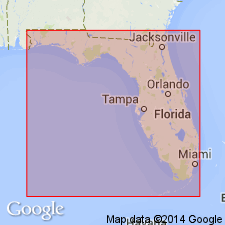
- Usage in publication:
-
- Bone Valley gravel
- Modifications:
-
- Original reference
- Dominant lithology:
-
- Gravel
- Marl
- AAPG geologic province:
-
- Florida platform
Summary:
Table opp. p. 50 and p. 138-141. Bone Valley gravel. Light-colored gravel and marl, containing phosphatic pebbles. Consists of a fine-grained matrix containing pebbles of phosphate or chert, fragments of bone and other organic remains. Matrix is commonly a marly clay, though sand is not uncommon, especially in upper part of formation. The finer grained material is soft and plastic when wet, but upon exposure to the air hardens to a firm mass. The formation comprises nearly all of the pebble phosphates now being mined in Florida. Thickness not more than 30 feet. Rests, probably unconformably, on Pliocene marls or older rocks. Overlain, unconformably, by Pleistocene sands. Is believed to be younger than "Arcadia marl" and older than upper beds of Caloosahatchee marl. Is a nonmarine deposit, probably in part contemporaneous with Alachua clay. [Age is early(?) Pliocene.]
[Named from exposures at town of Bone Valley, west of Bartow, Polk Co., southern central FL.]
Source: US geologic names lexicon (USGS Bull. 896, p. 234).
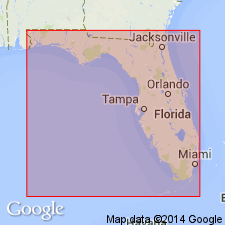
- Usage in publication:
-
- Bone Valley gravel*
- Modifications:
-
- Areal extent
- AAPG geologic province:
-
- Florida platform
Summary:
Pg. 162. Bone Valley gravel. The "land-pebble" phosphate deposits make up large part of Bone Valley gravel, which rests unconformably on Hawthorn formation (from which it is in part derived) and is unconformably overlain by Quaternary. [Age is early(?) Pliocene.]
Source: US geologic names lexicon (USGS Bull. 896, p. 234).
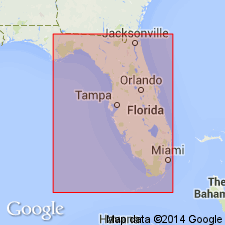
- Usage in publication:
-
- Bone Valley Member
- Modifications:
-
- Principal reference
- Revised
- Biostratigraphic dating
- AAPG geologic province:
-
- South Florida province
Summary:
Bone Valley is demoted herein to member status in the Peace River Formation (new name) of the Hawthorn Group. A principal reference section is designated in core W-8879 (NE1/4SW1/4 sec. 24, T29S, R24E, Polk Co., FL). Interval occurs between 91.5 ft and 56 ft. Rank reduction is suggested because of unit's limited areal extent, the gradational nature of its boundaries and its lithologic similarities to the Peace River Formation. Areal extent is limited to the western half of Polk Co., the eastern one-third of Hillsborough Co., northeast Manatee Co., and northwest to north-central Hardee Co. Outside this area individual beds of the Bone Valley lithology occur intermixed with Peace River sediments but are not differentiated. Unit disconformably overlies the Arcadia Formation (redefined in this report) in some areas, but overlies and interfingers with the upper Peace River Formation in others. Unit unconformably underlies unnamed sands throughout its extent. Age of the unit, which is based on vertebrate fossils, ranges from latest early or early middle Miocene to very early Pliocene. The Bone Valley is correlated with part of the Intracoastal Formation in the Apalachicola Embayment. Part of the Bone Valley is correlated with the Coosawhatchie and Statenville Formations of north FL and GA, the Screven Formation of the GA coastal plain, and the Pungo River Formation of NC.
Source: GNU records (USGS DDS-6; Reston GNULEX).
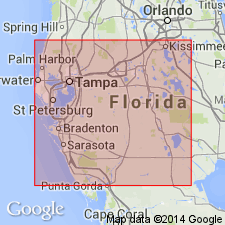
- Usage in publication:
-
- Bone Valley Formation*
- Modifications:
-
- Revised
- AAPG geologic province:
-
- Florida platform
Summary:
The Bone Valley Formation is revised as a formation of the Hawthorn Group in FL. Unit is considered uppermost formation of Hawthorn Group, and overlies the Peace River Formation. It is of Miocene and Pliocene age. The upper part (0-12 meters) of the Bone Valley Formation in the Land-pebble district correlates with the Tamiami Formation of the southern extension. The lower part (0-15 m) of the Bone Valley consists of sandy, clayey, and pebbly phosphorite with abundant aluminum phosphate where it is leached; the upper part is clayey sand with aluminum and iron phosphate where it is leached.
Source: GNU records (USGS DDS-6; Reston GNULEX).
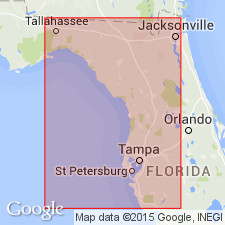
- Usage in publication:
-
- Bone Valley Formation
- Modifications:
-
- Biostratigraphic dating
- AAPG geologic province:
-
- Florida platform
Summary:
Miocene land mammals are now known from five formations in the Hawthorn Group of northern peninsular FL and the eastern panhandle, including the Parachucla, Penney Farms, Torreya, Marks Head, and Statenville, and from two units in central FL, the Arcadia and Bone Valley Formations. (The Bone Valley Formation of this report is equivalent to the Bone Valley Member of the Peace River Formation of Scott, 1988.) The upper Bone Valley Formation is the only unit in the Hawthorn Group that is Pliocene. Pliocene age is based on occurrence of the late Hemphillian Palmetto Fauna in the upper pebble phosphate beds. Miocene land mammal faunas from the Bone Valley include the middle Miocene Bradley and Agricola Faunas. The Bradley Fauna is late Barstovian (Serravallian, 12.5-11.5 Ma); the Agricola Fauna is early Clarendonian (late Serravallian, 11.5-10.5 Ma. The underlying Arcadia Formation is Oligocene and Miocene.
Source: GNU records (USGS DDS-6; Reston GNULEX).
For more information, please contact Nancy Stamm, Geologic Names Committee Secretary.
Asterisk (*) indicates published by U.S. Geological Survey authors.
"No current usage" (†) implies that a name has been abandoned or has fallen into disuse. Former usage and, if known, replacement name given in parentheses ( ).
Slash (/) indicates name conflicts with nomenclatural guidelines (CSN, 1933; ACSN, 1961, 1970; NACSN, 1983, 2005, 2021). May be explained within brackets ([ ]).

